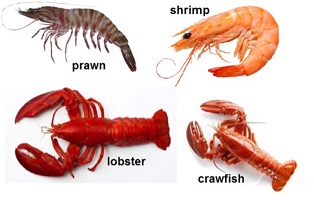How to Differentiate Between Crayfish, Prawn, & Shrimp
Crayfish, Prawn, and Shrimp | Crayfish VS Prawn VS Shrimp. Many questions arise as regards the confusion people find between Crayfish, Prawn, and Shrimp.
Please watch for a clearer definition

How To Distinguish Between Crayfish, Prawn, and Shrimp
When comparing their physiques, crayfish can be easily distinguished from prawns and shrimps because crayfish are bigger than prawns.
Even a child as young as six can tell the difference between the two. The only place it gets hard is with prawns and shrimps, as they have a very similar appearance.
Differentiating between crayfish, prawns, and shrimp can be challenging for many people, as these crustaceans share similarities in appearance.
However, there are key features that distinguish them from one another. Here are 40 detailed questions and answers to help you understand how to differentiate between crayfish, prawns, and shrimp:
This is because a variety of marine creatures, especially crustaceans, all look alike but are very different.
The main reason for this is the alike structure and almost the same body between the three.
Please Read >>> Health Benefits of Prekese (Tetrapleura Tetraptera) | Aiden Fruit
How to Differentiate Between Crayfish, Prawn, & Shrimp
Crayfish, Prawns, and Shrimp belong to the same family and are crustaceans but have many variations including their production countries.
People favor one over the other when it comes to food because of differences in taste between them.
In America, both shrimps and prawns are called shrimps while prawns are called by the Brits and Australians.
This has confused so many people the more, as well as citizens of those countries.
Great confusion often arises when it comes to distinguishing between prawns, and shrimp.
In this article, I will try as much as possible to highlight what distinguishes these crustaceans – Crayfish, Prawn, and Shrimp.
In some cases, it is easy to spot, especially for crayfish.
What Is the Difference between Prawns, Shrimp & Crayfish? | Crayfish VS Prawn VS Shrimp
-
Definition
Shrimp: any small, long-tailed, mostly marine crustaceans of the decapod suborder Natania, some species of which are used as food.
The baboon is also called a prawn, but it is not the same animal. Shrimp have a lamellar gill, a side plate that covers the front and back parts and carries their eggs outside of their bodies beneath their tails.
While, Prawns have branching gills, and side plates that overlap tile-like from front to back, and they carry their eggs inside their bodies near their tails.
Shrimp Features
- Most are under 8 inches long.
- Live in freshwater or saltwater.
- Can be found on sandy or muddy bottoms.
- The most common in the US are white, brown, or pink.
- There are over 1,900 species.
- Are a good source of protein, and are low in fat and calories.
- Are high in cholesterol.
Crayfish, Prawn, and Shrimp – Differences between Prawns and Shrimps
This is where it can be confusing because prawns and shrimp look very similar. If you ask other people how they distinguish between the two, they will tell you that one is bigger than the other. This is in reality wrong. They belong to the same family so they look very similar.
Body Structure/Shape of Shrimp VS Prawn
If you look at the body composition of these two, you will see the difference. Prawns have claws on three of their five pairs of legs while shrimp have claws on two of their five pairs of legs.
Moreover, you will see a marked bend on the shrimp against the prawn, which has its bend in form of a curve. There are no marked or sharp bends on the prawn
What is Crayfish?
Crayfish is a water crustacean at night. It is somewhat similar to the smaller lobsters and is more common in rivers and streams. Crayfish are normally meatier and have a strong aroma in them. They are low in salt, sweet, and have little mineral flavor.
Crayfish have no pincers and have feather-like gills. Their fossils can be found for about 30 million years. Crayfish fertilize their eggs in their body. They feed on plants and animals, either live or decaying
Crayfish are used as pets and are kept in freshwater aquariums and can do anything literally and are therefore omnivores. Being omnivores in nature, they can cause ecological damage when introduced to non-native water bodies.
What is Prawn?
Prawn is a common name used for small aquatic crustaceans.
After years of confusion and a lack of scientific data, Shrimp and prawns are in interchangeably used these days. But, there is a big difference between Prawns and Shrimp.
The Exo or Outer bone feature of the Prawn does not permit it to bend at all so the prawns are almost straight.
Prawns have their claws on three pairs of legs and have the largest pincers present on the second pair of legs. Prawn release their fertilized eggs into the water which makes the eggs grow.
Speaking of taste, prawn has a slightly sweet taste that goes with it and it is seafood. People around the world love to eat it in a variety of dishes and versions.
The Indian prawn of the Fenneropenaeus is one of the world’s largest trading species. Prawns are found mainly in the Indo-west Pacific, India, South-eastern Africa, Malaysia, Indonesia, northern Australia, and southern China.
Prawns and crayfish have very different tastes and prawns are smaller in size than Crayfish.
Crayfish VS Prawn VS Shrimp – Crayfish, Prawn, and Shrimp
- Prawn VS Crayfish
The difference between prawns and Crayfish is that prawns are saltwater crustaceans and crayfish are freshwater crustaceans. Although they may look similar, if one does not look very closely, they have tons of variation.
One significant difference can be seen in their reproductive process.
Second, crayfish are small freshwater shellfish with five pairs of legs; they look like little lobsters, are lobster-related, and are very tasty.
While a prawn is more like a shrimp, though it is more significant in size, is well-thought-out marine life, so it does not live in freshwater.
Crayfish have claws, and their flesh is less sweet than that of prawns. Furthermore, you don’t get as much meat from the crayfish. Prawns are closely related to shrimp.
Crayfish are also known as crawfish and crawdads. Prawns have more protein than crayfish, possibly because they are bigger and hold more meat.
The prawns are very natural to peel and eat, while the crawfish have a shell that is hard to break.
Crayfish VS Prawn VS Shrimp Bottom Line
All things considered, prawn is highly desirable because of its flavor, ease of peeling, and eating.
How to Tell the Difference between Crayfish, Prawns, and Shrimp
Prawns are smaller than shrimps and are closely related to them. They have branching gills, unlike crayfish.
Unlike other crustaceans, have claws on three pairs of their legs. It is also clear that, unlike other decapods, prawns do not brood their eggs on Pleopads.
What is the difference between shrimp and prawns and crayfish? How to Tell Crayfish, Prawns, and Shrimp Apart
Prawns and crawfish both live in water, though prawns prefer saltwater and crawfish prefer freshwater.
The vast majority of shrimp (and thus prawns) live in saltwater. Nonetheless, some shrimp, such as the big claw river shrimp, live in freshwater.
What’s the difference between crayfish and shrimp?
Crawfish and shrimp differ the most in terms of size, morphology, and water type in which they live.
Crawfish are larger than shrimp, have long, thin pincers that shrimp lack, and live entirely in freshwater, whereas shrimp live in both freshwater and saltwater.
How to differentiate between shrimp and prawns? How do you tell the difference between shrimp and prawns?
Pincers and claws: Shrimp have claws on both pairs of legs, with the front pincers being the largest.
Prawns have claws on three pairs of legs, with the second pincers being larger than the first.
Is a crayfish the same as a shrimp? Is a crayfish a shrimp?
Crayfish and shrimp are bottom-dwelling crustaceans classified as Malacostraca. Scuds and aquatic sow bugs (Isopoda) are also included in this class (Amphipoda).
Crayfish, with 315 freshwater species, is a much more diverse group than freshwater shrimp, which have only 19 species.
Is Nigerian crayfish shrimp?
Based on shrimp characteristics, I believe the crayfish we have in Nigeria is more like shrimp.
As a result, crayfish can be safely referred to as dried shrimps. They range in size from very small to large enough to be mistaken for prawns.
Does crayfish taste like prawn?
Crawfish and prawns are both crustaceans, but prawns have branching gills and live in salt water, whereas crawfish live in fresh water and have featherlike gills.
A crawfish tastes more like a lobster in terms of flavor. Prawns have a more shrimp-like flavor, despite being smaller and sweeter.
Do crayfish and shrimp have the same flavor? Do crayfish and shrimp taste the same?
Many people compare the flavor of crawfish to that of shrimp and crab because they are slightly salty and a little sweet and have a bit of mineral flavor.
What are big crayfish called?
The Tasmanian giant freshwater crayfish (Astacopsis gouldi), also known as the Tasmanian giant freshwater lobster, is the world’s largest freshwater invertebrate and freshwater crayfish species.
Crayfish have claws and have less sweet flesh than prawns ~~ Difference between crayfish and shrimp taste
Furthermore, the crayfish does not provide as much meat. Shrimp and prawns are related. Crayfish are also referred to as crawfish and crawdads.
Which do you prefer, shrimp or crawfish? The one that tastes better shrimp or crawfish?
Which is better, shrimp or crawfish? The answer is a personal preference.
Crawfish have a milder, sweeter flavor that is similar to lobster. Shrimp have a slightly stronger flavor and are slightly salty.
Difference between crayfish and prawns
Crayfish are much larger than prawns. Another distinction is that prawns are saltwater crustaceans, whereas crayfish are freshwater crustaceans.
Crayfish are related to lobsters and are also known as crawfish and crawdads.
Shrimp versus prawn versus crayfish ~ Shrimp vs prawn vs Crayfish
The prawn is smaller than shrimp and is closely related to them. They have branching gills, unlike crayfish.
Unlike other crustaceans, have claws on three pairs of their legs. It is also clear that, unlike other decapods, prawns do not brood their eggs on Pleopads.
Prawn and crayfish recipes ~ what is the best combination with prawns?
What Food Pairs Well With Shrimp? 48 Side Dishes to Serve with This Shellfish
- Salad of Burrata with Stone Fruit and Asparagus.
- Mediterranean Roasted Vegetables
- Ginger Jasmine Rice
- Patatas Bravas with Saffron Aioli
- Steamed Seasoned Eggplant
- Pan-Roasted Broccoli’Steaks’ with Garlic-Sesame Vinaigrette
- Cornbread baked in a cast iron skillet.
Are prawns and crayfish the same thing?
Although they are related, prawns and crayfish are not the same. Crayfish and prawns can be distinguished by their physical appearance.
Crayfish are much larger than prawns. Another distinction is that prawns are saltwater crustaceans, whereas crayfish are freshwater crustaceans.
Difference between prawn and shrimp ~ what is the difference between shrimp and prawns and scampi?
The difference between scampi (langoustine) and prawns is that scampi are members of the lobster family, whereas prawns are members of the shrimp family.
The langoustine and gambas are caught in the North Sea, but not the langoustine.
Crayfish and shrimp aquarium: Can crayfish be kept with shrimp?
It is not recommended to keep them together because shrimp may be considered a welcome snack.
Plants are not eaten, so dwarf crayfish can be kept in planted aquariums. Their lifespan ranges from 1.5 to 2 years.
What are crayfish, prawns, and shrimp?
Crayfish, prawns, and shrimp are crustaceans belonging to the order Decapoda. They are characterized by a hard exoskeleton, ten legs, and a body divided into segments.
What is the primary difference between crayfish, prawns, and shrimp?
The primary difference lies in their anatomical features, particularly the structure of their gills, body shape, and size.
How are crayfish typically characterized?
Crayfish have a lobster-like appearance with large, noticeable claws. They are freshwater crustaceans and are commonly found in streams, rivers, and ponds.
What distinguishes prawns from crayfish and shrimp?
Prawns have elongated bodies and branching gills. They are typically found in both freshwater and marine environments.
Are crayfish and prawns always distinguishable by their habitat?
No, because some species of crayfish can also inhabit brackish and marine waters, blurring the habitat distinction between crayfish and prawns.
What are the key features of shrimp?
Shrimp have a slender body, with a more pronounced curvature compared to prawns. They are primarily marine but can also be found in freshwater.
Can size be a reliable factor in differentiating these crustaceans?
Yes, size can be a useful distinguishing factor. Crayfish are generally smaller, while prawns and shrimp can vary in size, with some species reaching substantial lengths.
How are the claws or pincers of crayfish different from those of prawns and shrimp?
Crayfish have large, robust claws, while prawns and shrimp have smaller, more delicate claws.
Do crayfish, prawns, and shrimp have distinct colors that set them apart?
Coloration varies among species, making it less reliable for differentiation. However, some crayfish have more vibrant colors compared to prawns and shrimp.
What is the role of gills in differentiating these crustaceans?
The structure of the gills is crucial. Prawns have branching gills, while crayfish and shrimp have lamellar or plate-like gills.
Can the body shape alone be used to distinguish between crayfish, prawns, and shrimp?
Body shape is a significant factor. Crayfish have a robust, lobster-like body, prawns have a more elongated body, and shrimp have a slender, curved body.
In terms of taste and culinary use, are there notable differences between crayfish, prawns, and shrimp?
While there are subtle flavor differences, they are often used interchangeably in cooking due to their similar taste and texture.
Are there specific regions of the world where crayfish, prawns, or shrimp are more commonly found?
Yes, the distribution of these crustaceans varies globally. Crayfish are often found in North America, prawns are widespread in Asia, and shrimp are found in various coastal regions worldwide.
How do the walking legs of crayfish differ from those of prawns and shrimp?
Crayfish have larger, sturdier walking legs compared to the more slender and delicate legs of prawns and shrimp.
Do crayfish and prawns exhibit different behaviors?
Yes, crayfish are known for their burrowing behavior, while prawns may exhibit more active swimming behaviors.
Are there any distinctive markings on the bodies of crayfish, prawns, or shrimp that aid in identification?
While some species have specific markings, they are not universal, and relying solely on markings for identification may be unreliable.
Can the presence of chelae (claws) alone determine the species?
Chelae can be indicative of the species, but other factors such as body shape, size, and habitat must be considered for accurate identification.
How do the antennae of crayfish, prawns, and shrimp differ?
Crayfish have shorter antennae, while prawns and shrimp have longer and more pronounced antennae.
Are there any morphological features on the exoskeleton that can be used for differentiation?
The shape and spines on the exoskeleton can vary, but they are not consistent enough for reliable identification.
Can the eyes of crayfish, prawns, or shrimp be used for differentiation?
The eyes of crayfish are typically stalked, while those of prawns and shrimp are usually not as prominent.
Do crayfish, prawns, and shrimp have different reproductive strategies?
While reproduction varies among species, there is no universal reproductive feature that distinguishes crayfish, prawns, and shrimp.
Can one rely on the taste alone to identify whether they are consuming crayfish, prawns, or shrimp?
No, the taste alone is not a reliable indicator. The culinary preparation and seasoning can significantly influence the flavor.
How do the digestive systems of crayfish, prawns, and shrimp differ?
There are subtle differences in the digestive systems, but these are not easily observable without detailed anatomical examination.
Are there any notable differences in the habitat preferences of crayfish, prawns, and shrimp?
Crayfish are often found in freshwater habitats, prawns inhabit both freshwater and marine environments, and shrimp are primarily marine but can also be found in freshwater.
Can one differentiate based on the number of segments in the body?
Crayfish typically have a more segmented body than prawns and shrimp, but this alone is not a definitive factor for differentiation.
How do the appendages near the mouth differ among crayfish, prawns, and shrimp?
The mouthparts and appendages near the mouth exhibit subtle differences, but these are often challenging to observe without close examination.
Are there specific adaptations that crayfish, prawns, or shrimp have developed for survival in their respective environments?
Yes, adaptations vary based on the habitat, and they include features like camouflage, burrowing abilities, and defensive mechanisms.
Can one differentiate between crayfish, prawns, and shrimp based on their swimming abilities?
While crayfish are not strong swimmers and often crawl along the bottom, prawns and shrimp are more adept swimmers.
How do the reproductive organs of crayfish, prawns, and shrimp differ?
The reproductive organs can show subtle differences, with variations in the structure of the gonopods or swimmerets. However, these differences may not always be apparent without a close examination.
Can the presence of a rostrum (a beak-like projection) on the head be used for differentiation?
Yes, the presence and shape of the rostrum can be a distinguishing feature. Crayfish often have a prominent rostrum, while prawns and shrimp may have shorter or differently shaped rostra.
How do the molting processes of crayfish, prawns, and shrimp differ?
Molting processes are similar, involving the shedding of the exoskeleton to allow for growth. However, the frequency and specific molting behaviors may vary among species.
Can the habitat’s salinity be a reliable indicator for distinguishing between crayfish, prawns, and shrimp?
While it can provide a general clue, some crayfish can adapt to brackish or marine environments, and certain shrimp can also be found in freshwater.
Are there any unique behaviors exhibited during the mating rituals of crayfish, prawns, or shrimp?
Mating rituals vary among species, with some displaying specific courtship behaviors or posturing during the reproductive process.
How does the arrangement of the abdominal segments differ among crayfish, prawns, and shrimp?
Crayfish often have a more compact and segmented abdomen compared to the elongated abdomen of prawns and shrimp.
Can the geographic location where these crustaceans are found be used as a reliable differentiation factor?
While geographic location can provide some clues, it is not a definitive factor due to the global distribution of certain species.
How do the sensory organs, such as antennae, differ in length and structure?
Crayfish have shorter antennae, prawns have longer antennae, and shrimp typically have moderately sized antennae.
Can the color and pattern of the exoskeleton be used for species identification?
While some species may have distinctive colors and patterns, relying solely on this factor can be misleading due to the variability within each species.
How do the walking appendages contribute to the locomotion of crayfish, prawns, and shrimp?
Crayfish use their robust walking legs for crawling, prawns exhibit a more versatile use of their legs for both crawling and swimming, while shrimp rely on their slender legs for swift swimming.
Can the presence of certain parasites or symbiotic organisms be indicative of the species?
The presence of parasites or symbiotic organisms is not a reliable indicator, as these can be found across various species in different environments.
How do the lifespans of crayfish, prawns, and shrimp differ?
Lifespans vary among species and are influenced by factors such as environmental conditions, predation, and reproductive strategies. Generally, shrimp tend to have shorter lifespans compared to some crayfish and prawn species.
In conclusion, differentiating between crayfish, prawns, and shrimp requires a comprehensive understanding of various morphological, anatomical, and ecological factors. While some characteristics may be distinctive, it’s crucial to consider a combination of features for accurate identification. Close observation and, if necessary, consultation with experts or reference materials can enhance the ability to distinguish these crustaceans accurately.


